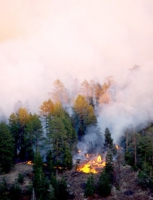Forest experts generally agree that as climate change makes the world warmer and drier, wildfires will break out more often. This means more destruction of property, more government dollars spent on fire crews and more plumes of nasty, polluting smoke smudging up summer skies.
But scientists aren't sure whether smoke from wildfires causes climate change. Smoke, it turns out, is tricky stuff, with properties that aren't easy to plug into the computer models that help predict how climate change might play out.
"Biomass burning is really complicated," said Allen Robinson, Lane professor in mechanical engineering at Carnegie Mellon University in Pittsburgh. There are many different types of fuels, Robinson said, from ponderosa pine trees to peat, and "they burn in a very poorly controlled manner, so it's difficult to get your arms around the problem."
New research published by Robinson and others yesterday in the journal Nature Geoscience tries to give climate modelers a better idea of what smoke does when it enters the atmosphere. It suggests that although it's not on the same level as fossil fuel emissions, smoke could be worsening climate change more than previously thought.
Sorting out the color of smoke
When smoke enters the atmosphere, its particles react to sunlight in different ways. One kind of smoke particle—what is usually called soot—is dark and absorbs sunlight, meaning it warms the atmosphere. Other particles, called organic carbon aerosols, are made up of tens of thousands of different molecules that have both warming and cooling effects—some absorb sunlight, some reflect sunlight, but the net effect is hard to determine.
To make climate models more workable, scientists assumed that organic carbon aerosols were generally lighter in color, with an overall cooling effect. Today, many climate change projections rely on the idea that the respective warming and cooling properties of soot and organic carbon aerosols cancel each other out, meaning smoke's impact on the climate isn't that significant.
But through a series of experiments at the U.S. Forest Service's Fire Sciences Laboratory in Missoula, Mont., Robinson and his colleagues think this assumption might have to change.
Setting a series of different fuels on fire, they captured the smoke in a large, baglike "smog chamber." They then analyzed the smoke and found that within the realm of organic carbon aerosols, particles called brown carbon, which absorb sunlight and warm the atmosphere, play an important role.
"If you add brown carbon into the picture, it pushes biomass burning clearly into the warming category," Robinson said.
This finding hasn't yet been applied to advanced climate change models, but the researchers ran a back-of-the-envelope calculation and found that forest fires or fires purposely set to clear land could well be joining fossil fuels emissions in playing a significant role in warming the planet.
Another of the report's authors, Manvendra Dubey, senior climate scientist at the Los Alamos National Laboratory in New Mexico, added that climate-warming brown and black carbon particles are found in smoke caused by hot, intensely burning flames—the kind of blazes that are starting to erupt more often.
"With climate change, some models indicate that fires will become hotter and more intense," Dubey said. "If you have hotter fires, then the potential to have more black and brown carbon increases."
Could controlling fires be a fast way to curb warming?
Nicolas Bellouin, who lectures on climate processes at the University of Reading in the U.K., said the finding "confirms something that we suspected—that the absorption from the smoke doesn't come from the black carbon alone."
However, Bellouin was pleased that the researchers had found a way to incorporate brown carbon into climate projections.
"From my selfish modeler point of view, that's really a great thing," Bellouin said.
Not all climate model scientists agreed. Kostas Tsigaridis, an associate research scientist at Columbia University and NASA's Goddard Institute for Space Studies, said he was skeptical about the paper's method to calculate how much brown carbon is found in smoke, saying he's seen similar experiments in the past that eventually didn't pencil out.
"As a global modeler, I am very excited to see such a simple parameterization, but I would hesitate to jump into it and apply it in my climate model right away," Tsigaridis said in an email.
But if the research ultimately proves reliable, Robinson and Dubey suggested it could have important policy implications. For example, limits on burning fields and forests to clear land for agriculture would become even more important to enforce and could be a strategy for developing nations to meet emissions reduction goals.
Bellouin said that such actions could have fast, positive results, because smoke particles have a relatively short life span in the atmosphere compared with carbon dioxide.
"If you manage to enact policies that reduce the emissions in very lasting ways over a number of years, you will get the benefit of not having the emissions very quickly," Bellouin said.
However, Robinson cautioned that even if wildfire smoke turns out to be helping to drive climate change, this should not replace efforts to cut fossil fuel emissions.
"Ultimately, CO2 is the biggest driver of climate change and a lot of CO2 comes from fossil energy," Robinson said. "Looking out into the future, at least in my opinion, if you turned off wildfires ... it's not going to avert climate change."

